Seagate's Momentus XT Reviewed, Finally a Good Hybrid HDD
by Anand Lal Shimpi on May 24, 2010 9:31 AM EST- Posted in
- Storage
- SSDs
- Seagate
- Momentus XT
- Hybrid Drive
- SSHDs
Overall System Performance using PCMark Vantage
Next up is PCMark Vantage, another system-wide performance suite. For those of you who aren’t familiar with PCMark Vantage, it ends up being the most real-world-like hard drive test I can come up with. It runs things like application launches, file searches, web browsing, contacts searching, video playback, photo editing and other completely mundane but real-world tasks. I’ve described the benchmark in great detail before but if you’d like to read up on what it does in particular, take a look at Futuremark’s whitepaper on the benchmark; it’s not perfect, but it’s good enough to be a member of a comprehensive storage benchmark suite. Any performance impacts here would most likely be reflected in the real world.
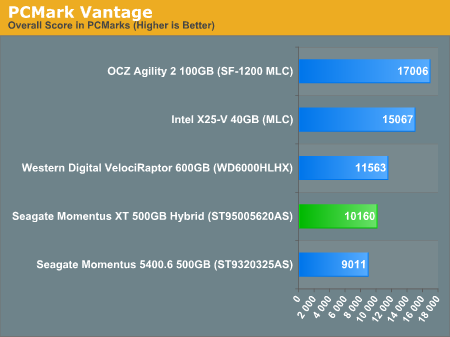
The PCMark Vantage Suite puts the Momentus XT smack in the middle of the 5400.6 and the VelociRaptor. The individual suites generally tell a similar story, although in some cases the drive actually outperforms the VelociRaptor.
The memories suite includes a test involving importing pictures into Windows Photo Gallery and editing them, a fairly benign task that easily falls into the category of being very influenced by disk performance.
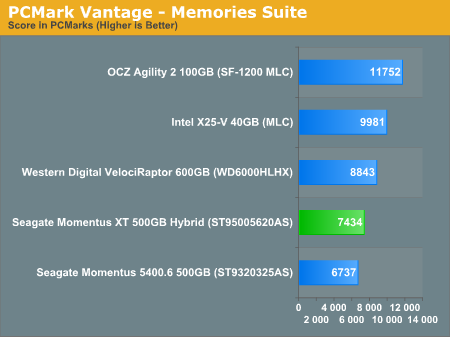
The TV and Movies tests focus on on video transcoding which is mostly CPU bound, but one of the tests involves Windows Media Center which tends to be disk bound.
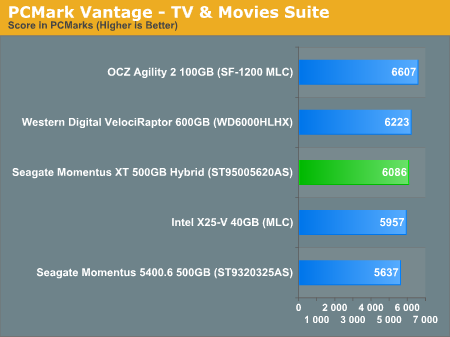
The gaming tests are very well suited to SSDs since they spend a good portion of their time focusing on reading textures and loading level data. All of the SSDs dominate here, but as you'll see later on in my gaming tests the benefits of an SSD really vary depending on the game. Take these results as a best case scenario of what can happen, not the norm.
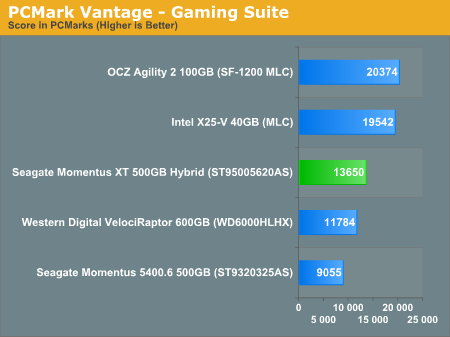
In the Music suite the main test is a multitasking scenario: the test simulates surfing the web in IE7, transcoding an audio file and adding music to Windows Media Player (the most disk intensive portion of the test).
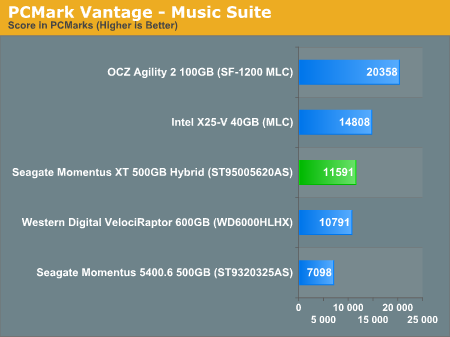
The Communications suite is made up of two tests, both involving light multitasking. The first test simulates data encryption/decryption while running message rules in Windows Mail. The second test simulates web surfing (including opening/closing tabs) in IE7, data decryption and running Windows Defender.
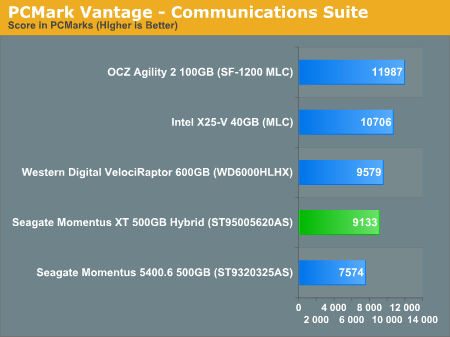
I love PCMark's Productivity test; in this test there are four tasks going on at once, searching through Windows contacts, searching through Windows Mail, browsing multiple webpages in IE7 and loading applications. This is as real world of a scenario as you get and it happens to be representative of one of the most frustrating HDD usage models - trying to do multiple things at once. There's nothing more annoying than trying to launch a simple application while you're doing other things in the background and have the load take forever.
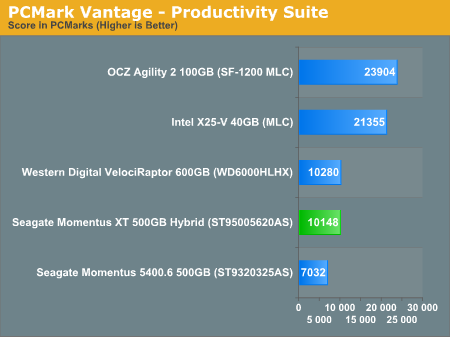
The final PCMark Vantage suite is HDD specific and this is where you'll see the biggest differences between the drives:
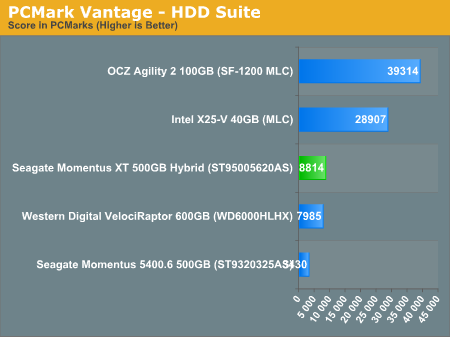










120 Comments
View All Comments
wagsbags - Monday, May 24, 2010 - link
Most SSDs use wear leveling algorithms or compression or some other fairly complicated mechanism to ensure reliability. Seagate wanted to make this as simple as possible while still being reliable.codedivine - Monday, May 24, 2010 - link
Here is a request for a test. What happens in dual-boot scenarios? If I boot into Windows 7 and then lets say into Ubuntu, then I expect the drive will have some trouble determining what to cache in its relatively small 4GB NAND.teohhanhui - Monday, May 24, 2010 - link
"The drive looks at access patterns over time (most likely via a history table of LBAs and their frequency of access) and pulls some data into the NAND. If a read request comes in for an LBA that is present in the NAND, it's serviced out of the 4GB chip. If the LBA isn't present in the NAND, the data comes from the platters."It should not matter what OS you're using.
leexgx - Monday, May 24, 2010 - link
it works at an very low level at LBAbelow is simplified
if LBA 50 is accessed say 2 times or more it then gets added to the flash if LBA 50 is over written it invalidates the LBA 50 block from the flash (its bit more then what i have say but basically what it does)
this drive does not talk to the OS at all when putting stuff onto the flash it makes an history of what parts of the disk are accessed the most and puts it on the flash (FIle or not)
the disk does not care what OS is running as its only looking at the History of the LBA access on the hdd side of this drive, so there should no issues using these drives in raid as it works at the LBA level of whats accessed the most
even better as each drive has 4gb of cache on them and raid 0 spreads data across muti disks the flash can be 4gb x N1 so if you have 4 XT drives you have 16gb of read cache flash available so if you open or use upto 16gb of files/LBA blocks that norm never change and are in use often they be cached so most of the reads come from the flash and Writes would goto the disk (if an Write and read are going on often the spinning disk maybe often only Writing most of the time as the reads would come from the flash)
nafhan - Monday, May 24, 2010 - link
The hard drive's firmware controls what gets cached. If you went back and forth between two OS's, you'd probably end up with either one or neither of them cached. The article explains that the best case scenario for a hybrid drive is where your most frequently used applications can fit within the 4GB of flash memory.Exelius - Monday, May 24, 2010 - link
Any chance of seeing a desktop version of this drive?While I know you prefer the discrete SSD+RAID solution, there's something to be said for simplicity (from an end user perspective; at least.) I would personally love to see a 1TB drive with around 32 GB of NAND for around $200. Given that both 1TB drives and 32GB SSDs are available for under a bill, this should be doable, right?
And on a different note; I'd be interested in seeing how a similar drive with a much larger flash cache performs in an enterprise scenario. Would the sync algorithm kill performance? Or would a larger cache allow wear leveling to make up for an increase in IOPS?
YellowWing - Monday, May 24, 2010 - link
I second that! 1 TB disk with 32 GB NAND for a reasonable price in a 3.5 inch form factor would get my dollar. Even if it were only a read cache.GourdFreeMan - Monday, May 24, 2010 - link
32GB of SLC would push the price of such a drive beyond $400 once manufacturer’s margins are taken into account with current generation flash. If MLC could be used instead, the price might be pushed down into the $250 range for your hypothetical drive, but it would have to cache data far less frequently to avoid wearing out the flash (or have to include a real SSD-like controller and some extra flash as spare area, once again driving up the price).mwagers - Monday, May 24, 2010 - link
Hows the vibration? I am trying to find a HD for my macbook pro and cant seem to find a 7200 that doesnt vibrate the casing. How does this one fair?JohnnyComeLately - Monday, June 6, 2011 - link
I just put this drive in my 15" MacBook Pro. There is a slight increase, but it's very very slight. What I think you'll notice more over the OEM drive is the noise. When the fans are off, and I'm in a quiet room, normally my MBP makes nearly no noise. I can hear this Momentus' platter spinning. It's not obnoxious, bad, but you will notice it if you're in a quiet room.